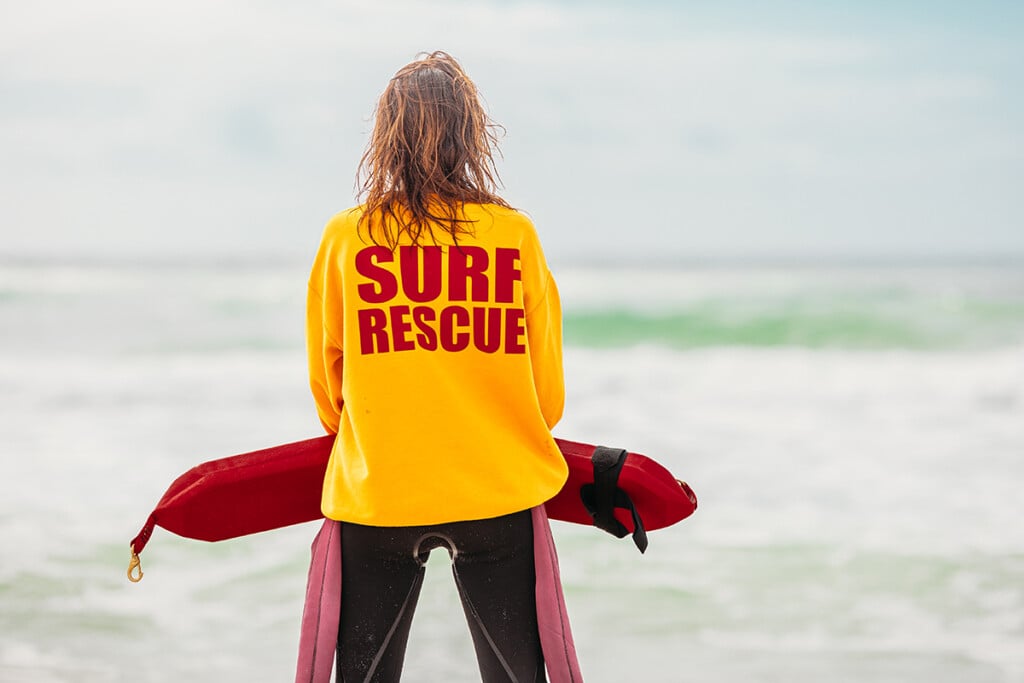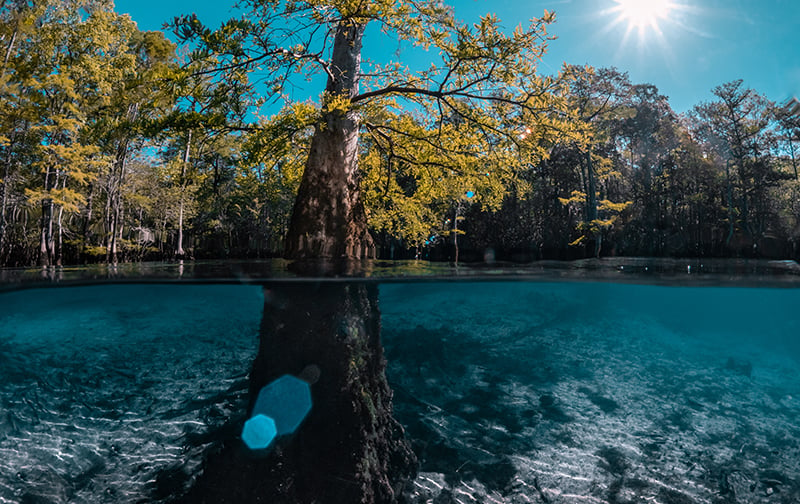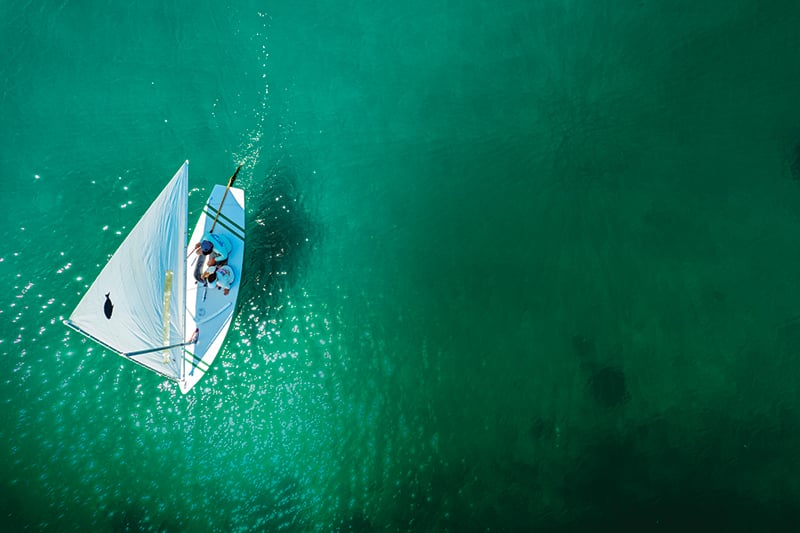Guarding on the Gulf
Emerald Coast dream job comes with high-stakes responsibilities

On any given day, some 9–18 lifeguards patrol Okaloosa County beaches stretching from John Beasley Park on the east end to El Matador condominiums on the far west side.
Return lifeguard KaLee Pirtle says there’s no place she’d rather be.
A transplant from Tennessee, Pirtle got her lifeguarding start at area pools. She moved to the Emerald Coast for her dream job with Okaloosa County Beach Safety three years ago.
“The most important thing for myself is being thankful that I’ve been presented with this opportunity,” Pirtle said. “Not everyone gets to be a beach lifeguard.”
And not everyone has the ability. During Okaloosa Island’s lifeguarding academy, physical training demands are nearly military.
Over two weeks in late February, 18 hopeful lifeguards are put to the test in a series of physical and standardized training. Both return lifeguards and rookies are required to achieve a 500-meter swim in under 10 minutes and a 10-minute mile on beach sand.
“That’s a pretty good feat. You have to be a good swimmer, more than competent, to get in 500 in 10 minutes,” said Rich Huffnagle, Okaloosa County Beach Safety chief. “You have to be fast, and that requires a level of fitness.”
Some recruits are accepted into the academy hitting a 12-minute mile or 12-minute swim. In their two weeks of training, they’re expected to reach that 10-minute mark.
“That tells you a lot about the person,” Huffnagle said of improving recruits. “They won’t quit, and that’s what we’re looking for.”

Each year, Okaloosa Island Beach Safety Chief Rich Huffnagle is tasked with staffing his 3-plus-mile beach jurisdiction with able and educated lifeguards. Photo by Boo Media
Returning lifeguards like third-year Pirtle benefit from the academy, too.
“For a lot of us, the last time that we were doing water rescues was back in October,” she said. “So it’s always good to have a refresher. And you’re able to push the rookies as well; you feed off of each other’s energy and push each other to do better.”
During water entry drills, trainees run into Gulf of Mexico waters up to knee-high depth, then begin porpoising in, a technique that mimics dolphins and is a fast way to get through shallow water. Pirtle noted that, at entry, it’s important to be aware of sandbars and water depths that shift at the shoreline daily.
Other training aspects include identification of medical supplies; interactions with beachgoers; CPR training using dummies; mock rescues where trainees act out everything from the water rescue to resuscitation on land; and identifying triggers that indicate a call to action or for backup.

Lifeguards including Cory Moore (picutred) and Pirtle keep busy protecting the area’s 1.8 million annual visitors and 20,000 full-time residents from red-flag conditions and unsuspecting rip currents. Photo by Boo Media
“There’re thousands of pieces of information that they’re absorbing within that two weeks,” Huffnagle said. “All the way from how to be a waterman to how to take care of a patient once on the beach.”
Lifeguards are taught to look for signs of distress from swimmers. A person not making any progress in the water, Huffnagle explained, is your No. 1 indicator that something is wrong. Other signs include the double arm backstroke, looking to or making eye contact with a lifeguard, head bobbing in and out of the water, and hair in the face.
“If they don’t have enough sense to get their hair out of their eyes, they’re probably struggling,” the Beach Safety chief said.
Academy graduates achieve 48 hours each of lifeguard and first responder training and receive American Heart Association (AHA) CPR and Basic Life Support (BLS) certifications.
First responder training teaches lifeguards to identify advanced life support (ALS) triggers that signal the need to call for paramedic services. These signs can occur post-water rescue or during a beached medical evaluation, such as heat exhaustion. Loss of consciousness is a key trigger.
“We consider everything out here on the beach as a harsh environment,” Huffnagle said. “When it’s 120 degrees on the sand, you want to get those patients out as fast as you can.”
In the dead of summer, conditions prove challenging for lifeguards, too. And physical exertion exacerbates depletion.

Photo by Boo Media
To combat fatigue and dehydration, lifeguards keep gallon jugs of water on hand and are directed to take frequent breaks at their posting’s closest access pavilion. Postings can be as far as 3 miles from headquarters, which are located at the Okaloosa Island Pier. Cooling off in the Gulf is helpful, and good relationships with area lodging permit lifeguards to dip in the cool pools or enjoy a moment of indoor AC.
On a normal day, about 10 lifeguards is a healthy number to manage patrols, with one lifeguard each covering a quarter-mile area. During peak season, that seemingly small zone can amount to 1,500–2,000 people. On those busy, red flag days, they’ll staff as many as 14 guards across the 3-plus miles of sand.
“Keeping people safe during rough surf days out here,” said lifeguard Pirtle, “that’s probably our biggest challenge.”

Lifeguard KaLee Pirtle. Photo by Boo Media
ATVs allow for constant patrolling and quick access when called to water rescues. The Okaloosa Island headquarters houses eight ATVs accessible to guards. A jet ski is also available for multi-victim rescues and to assist in hauling kayakers and paddleboarders back to shore when pulled out by the current.
When Huffnagle joined Okaloosa County Beach Safety 10 years ago, they were averaging 250–300 rescues annually. Today, that number is down to 30.
Preventative guarding has been essential. Lifeguards are trained to communicate with beachgoers and educate them on conditions.
“The biggest thing for us when we’re entering the season is to just get people knowledgeable,” Huffnagle said. “That’s our biggest tool, education. We want people to be safe. Come out and enjoy the beach, but be safe.”
Escaping a Rip Current
Most Gulf rips are relatively short, just the length of the sand bar where they can reach the intermediate area between Okaloosa Island’s two main sandbars.
“Most of those are 50–100 yards,” said Okaloosa County Beach Safety Chief Rich Huffnagle. “If you can remain calm and tread water, the surfline will throw you back on the beach.”
 Swimming parallel to shore, he says, is also good advice. But being caught in a rip can be disorienting and make navigating water while swimming difficult.
Swimming parallel to shore, he says, is also good advice. But being caught in a rip can be disorienting and make navigating water while swimming difficult.
“The biggest thing is just not to panic. That would be my best advice; don’t panic and just tread water.”
And, he says, “If you aren’t competent in the water, then don’t go in, especially when the surfs up.” Keep to the shallows of a couple of feet to cool off and enjoy the beach. “If you’re unsure about anything,” Huffnagle advised, “find a lifeguard and ask them.”
Beach Flags
Green – Low Hazard: Calm Conditions, caution is still advized.
Yellow – Medium Hazard: Moderate surf and/or currents.
Single Red – High Hazard: High surf and strong currents.
Double Red – Water Closed to Public: Water activity is prohibited.
Purple – Stinging Marine Life Present: Purple flags will be seen in conjunction with another flag color.
Daily beach flag conditions and updates
Okaloosa County: Text BEACH to 44144
Walton County: Text SAFETY to 31279
Bay County: Text PCBFLAGS to 888777
No Swim Zones
Differing from double red flags present on the main flag poles, no-swim zones are marked with two red flags staked near the shore. This indicates areas with rip currents. You may see no-swim zones on yellow or red flag days. If you see double red flags flying on the main flag poles, that indicates that the water is closed to the public. After marking a no-swim zone, lifeguards will interact with beachgoers in the area to inform and educate them.

